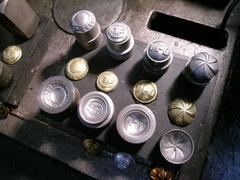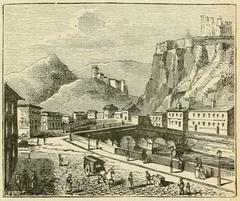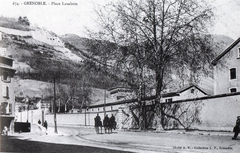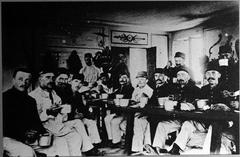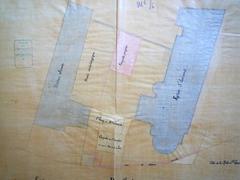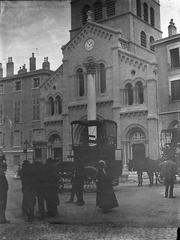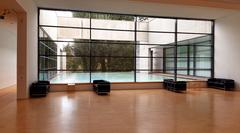
Charles-Berty Stadium Visiting Hours, Tickets, and Guide to Grenoble Historical Sites
Date: 04/07/2025
Introduction to Charles-Berty Stadium and Its Significance
Located in the heart of Grenoble, France, the former Charles-Berty Stadium was a cornerstone of the city’s sporting and cultural life. Inaugurated in 1936 within Parc Paul Mistral, it served as a multi-purpose venue for cycling, football, and rugby, embodying the city’s vibrant athletic traditions. Named for Charles Berty—a celebrated cyclist and French Resistance member—the stadium bore deep emotional significance, symbolizing resilience and community pride (Wikipedia; surlatouche.fr).
Though demolished in 2003 due to structural decline, the legacy of Charles-Berty Stadium lives on through the Stade des Alpes, a modern, eco-conscious facility built on the same site. Today, Stade des Alpes represents Grenoble’s ongoing commitment to sustainable urban development and serves as the city’s main venue for football and rugby (Ingerop; Stade Hypotheses).
This guide provides a detailed exploration of Charles-Berty Stadium’s history and evolution, practical information for visiting the site today, and recommendations for nearby historical attractions. Whether you’re looking for visitor hours, ticketing, accessibility, or cultural highlights, this resource is designed to help you make the most of your experience in Grenoble (France Voyage; Grenoble Tourisme).
Historical Overview
Origins and Construction
Originally named Stade Municipal or Stade Vélodrome de Grenoble, the stadium was initiated in the early 1930s as part of a modernization effort led by Mayor Paul Mistral. Construction began in the mid-1930s, culminating with its inauguration on June 14, 1936, during the city’s Fête de la Jeunesse. A month later, it hosted the finish of the 7th stage of the Tour de France, attracting up to 20,000 spectators (Wikipedia; routeyou.com).
The stadium featured a velodrome track and was built to accommodate diverse sporting and public events, with an initial capacity between 15,000 and 18,000.
Naming and Dedication
After World War II, the stadium was renamed to honor Charles Berty, a Grenoble-born cyclist and French Resistance hero who died in deportation in 1944. This dedication commemorated both his sporting achievements and his sacrifice for France (surlatouche.fr; lesanciensstade.unblog.fr).
Sporting Legacy
Cycling and the Velodrome: The velodrome hosted stages of the Tour de France and Critérium du Dauphiné Libéré, reflecting cycling’s popularity in Grenoble (Wikipedia).
Football: The stadium was the main home ground for local clubs, especially Football Club de Grenoble (later Grenoble Foot 38). Notably, on November 11, 1960, FC Grenoble defeated the French champions Stade de Reims 3-2 before a record 22,334 spectators (Wikipedia).
Rugby and Other Sports: The venue hosted rugby league and union matches, including international fixtures and a historic 1981 victory over the New Zealand All Blacks (Wikipedia).
Cultural and Social Role
Beyond sports, Charles-Berty Stadium was a community landmark, hosting concerts and gatherings. Its central park location made it accessible, and its association with Charles Berty cemented its symbolic status as a site of local pride and remembrance. Notably, Pink Floyd played a major concert there in 1988 (Wikipedia).
Decline and Demolition
By the late 20th century, the stadium suffered from outdated facilities and structural deterioration (surlatouche.fr). The decision to replace it came in the early 2000s, with the Stade des Alpes rising in its place. Charles-Berty Stadium was closed and demolished in 2003 (FIFA; ici-grenoble.org).
Visiting the Site Today
Parc Paul Mistral and Stade des Alpes
While Charles-Berty Stadium no longer exists, its location within Parc Paul Mistral remains a vibrant green space in central Grenoble. Visitors can stroll the park and view the Stade des Alpes, the modern stadium continuing the site’s sporting tradition.
- Parc Paul Mistral Hours: Open daily from dawn to dusk.
- Stade des Alpes: Offers guided tours and hosts football, rugby, and concerts. For event schedules and tickets, visit the Stade des Alpes Official Website.
Accessibility
Both the park and stadium are accessible via Grenoble’s tram and bus network. The C tram line stops nearby, and underground parking is available. Stade des Alpes includes step-free access, ramps, elevators, and designated seating for visitors with disabilities.
Nearby Attractions
Enhance your visit by exploring:
- Bastille Fortress: Reachable by cable car, with panoramic views.
- Musée de Grenoble: Renowned for its art collection.
- Old Town: Features historic squares, shopping, and dining.
Stade des Alpes: Modern Venue and Visitor Guide
Architecture and Sustainability
Stade des Alpes exemplifies modern, eco-conscious design—utilizing a metallic frame, glass, and wood purlins to harmonize with the park. Over 1,000 m² of photovoltaic panels contribute to its sustainability (Ingerop).
- Capacity: 20,068 seats under a transparent roof
- Event Hosting: Football (Grenoble Foot 38), rugby (FC Grenoble Rugby), ice hockey exhibitions, concerts, and festivals
- Sustainability: Built to High Environmental Quality (HQE) standards
Tickets and Entry
- Tickets: Purchase via GF38.fr or at the stadium on event days. Advance purchase is advised for major events.
- Entry: Gates open 1.5 hours before events. Bag checks and security screenings are standard; avoid bringing large bags.
Facilities
- Amenities: Snack bars, restrooms (including accessible facilities), and merchandise kiosks
- Seating: Modern, with excellent views
- Accessibility: Contact ahead for assistance if needed
Transport
- Public Transport: C tram line to Stade des Alpes stop; multiple bus routes serve the area
- Parking: 1,000-space underground lot, but can fill quickly during events
Visitor Experience and Practical Tips
Weather and Timing
Grenoble enjoys warm, sunny summers (24–29°C in July), but occasional rain is possible (Weather2Travel Grenoble). Winters are cold but seldom severe. Spring and autumn offer mild weather with fewer crowds.
What to Bring
- Weather-appropriate clothing (layers in winter, lighter gear in summer)
- Comfortable shoes for walking or standing
- Sun protection and a rain jacket in summer
- Reusable water bottle (fountains available)
- Light bag (subject to security restrictions)
Food and Refreshments
On event days, snack kiosks and food trucks offer sandwiches, pastries, and beverages. Nearby neighborhoods feature cafés and restaurants with local specialities.
Safety
Grenoble is generally safe. The stadium is family-friendly with reliable public transport and visible event security (HikersBay Grenoble). Standard precautions apply.
Photography and Visual Highlights
- Stadium: The transparent roof creates striking photo opportunities, especially at dusk.
- Parc Paul Mistral: Lush lawns and the Perret Tower
- Bastille Fortress: Sweeping Alpine views
 Alt text: Historic photo of Charles-Berty Stadium in Grenoble showcasing the velodrome and seating areas.
Alt text: Historic photo of Charles-Berty Stadium in Grenoble showcasing the velodrome and seating areas.
Virtual Tour of Parc Paul Mistral and Stade des Alpes
Frequently Asked Questions (FAQ)
Q: Can I visit Charles-Berty Stadium today?
A: No, it was demolished in 2003. The site is now part of Parc Paul Mistral, with the modern Stade des Alpes nearby.
Q: Are tickets required to visit the Charles-Berty Stadium site?
A: No tickets are needed for the park. For Stade des Alpes events, tickets can be purchased online or at the venue.
Q: What are Stade des Alpes’ visiting hours?
A: Open primarily for scheduled events; gates open 1–1.5 hours before. For tours, check the official site.
Q: Is the stadium accessible?
A: Yes, with ramps, elevators, and accessible facilities.
Q: What are Grenoble’s must-see historical sites?
A: Bastille Fortress, Musée de Grenoble, Old Town, and Paul Mistral Park.
Summary and Key Visitor Tips
- Location: Central Grenoble, in Parc Paul Mistral
- Legacy: Historic site of Charles-Berty Stadium, now home to Stade des Alpes
- Access: Tram, bus, bike, or car; accessible facilities available
- Tickets: Stade des Alpes events—purchase online or at the venue
- Surroundings: Parks, Bastille, museums, and vibrant city center
- Best Time: Spring, summer, and early autumn for events and pleasant weather
- Safety: Reliable, family-friendly, and well-served by healthcare
- Sustainability: Eco-friendly stadium and green urban planning
Useful Resources
- Official Grenoble Foot 38 website
- Grenoble Tourism Office
- Grenoble Public Transport (TAG)
- OStadium Stade des Alpes Info
- France Voyager: Best Things to Do in Grenoble
- Stadium Guide: Stade des Alpes
- Stade des Alpes Official Website
- Audiala App
Sources
- Charles-Berty Stadium Grenoble: History, Visiting Information & Legacy, 2025, surlatouche.fr (https://surlatouche.fr/grenoble-stades-rugby-football/)
- Wikipedia: Stade Charles-Berty, 2025 (https://fr.wikipedia.org/wiki/Stade_Charles-Berty)
- Stade des Alpes Grenoble: Visiting Hours, Tickets, Sporting Heritage, and Visitor Guide, 2025, Ingerop (https://www.ingerop.fr/en/project/grenoble-stadium/)
- Stade Hypotheses: Stade Charles-Berty, 2025 (https://stade.hypotheses.org/tag/stade-charles-berty)
- Visiting Charles-Berty Stadium in Grenoble: Hours, Tickets, and Nearby Attractions, 2025, France Voyage (https://www.france-voyage.com/tourism/grenoble-1505.htm)
- Practical Visitor Tips for Stade des Alpes, 2025, Stadium Guide (https://www.stadiumguide.com/stadedesalpes/)
- Grenoble Tourism Office, 2025 (https://www.grenoble-tourisme.com/fr/)
- FIFA: Stade des Alpes, 2025 (https://inside.fifa.com/news/stade-des-alpes-2905170)
- Audiala App, 2025 (https://audiala.com)

